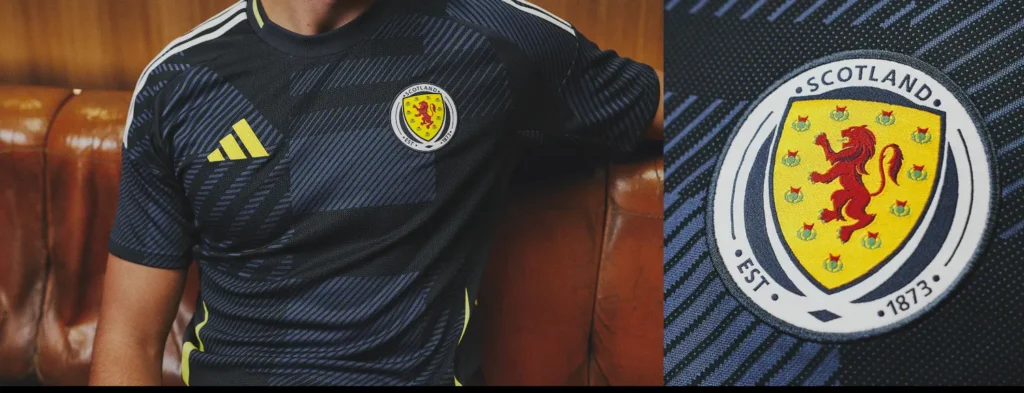
Every two seconds, somebody buys a football shirt. And that’s counting the shirts of the top ten clubs in Europe! Football shirts are big business, and they are getting more and more expensive. Today’s Manchester United shirt cost three times as much as thirty years ago! So, are greedy club owners ripping us off? It’s a bit more complicated than that. Welcome to Athletic Interest.
This article explains why football shirts are so expensive and who makes the most money selling them.
Evolution of Football Uniforms
Before breaking down the price of football uniforms, we must understand where they come from. Because in the beginning, there were no uniforms. In the middle of the 19th century, when football started to become popular, players would turn out in whatever they had to do. Teams were distinguished by wearing colored caps or scarves. The initial mention of “colors” dates back to 1857 in the rules of Sheffield FC, recognized as the world’s oldest football club.

The stipulation stated, “Each player must equip themselves with a red and dark blue flannel cap, with one color designated for each side.” Following this, many clubs dyed their shirts in distinctive club colors and affixed their logos to the chest. This original style lasted for almost a century. The only addition was the numbers on the back to make it easier for the fans to distinguish between players.
Introduction of Sponsorship

In the 70s, just as everything around football became more colorful, teams like Palermo and Hamburg were playing in pink. Additionally, the introduction of sponsor logos marked a significant change. In 1973, the German squad Braunschweig made history by being the first club to display a sponsor logo on its shirts, featuring the emblem of the liquor producer Jägermeister.
The move paid the team 100,000 German marks, introducing a new way of doing business with football worth millions today. However, the idea faced resistance, with the BBC refusing to broadcast matches featuring sponsored shirts, forcing clubs to remove sponsors’ logos. This stance changed when broadcasters started getting a slice of the pie.
Rise of Replica Kits

In the 90s, football experienced an injection of cash through lucrative broadcasting deals. The marketing of replica kits exploded, with every supporter expected to wear the current replica kit on matchday. Shirts had to look good on the pitch and when worn with jeans. Today, football shirts are not just sports attire; they are fashion, collectibles with cultural significance, and a significant revenue stream for clubs. The substantial kit deals struck with Adidas and Nike result in clubs such as Manchester United and Liverpool earning millions in cash annually, and the source of this significant revenue has to be identified: the fans.
The Price Dynamics
So, are clubs and brands increasing prices whenever they can? A typical football shirt today costs around three times as much as thirty years ago. But there is one self-evident reason for the change: inflation. According to the Bank of England, the average inflation since ’92 has been 2.8%. If you factor that in, €30 back then would be around 70 euros in today’s money. And that roughly aligns with the amount you would spend on a replica shirt in the present day.

That doesn’t mean that 70 euros for a football shirt is cheap, but it’s not like we’ve missed out on a better time – the typical football shirt is as expensive as ever.
Authentic vs. Replica Shirts
Before you head to the comments section, lecture us that most clubs sell their shirts for 100 euros or more, yes! That’s the so-called authentic version. So there are two versions of football shirts. They might look incredibly similar, but some significant differences exist between authentic and replica football shirts. The players on the pitch wear original shirts, while replica shirts are a cheaper option produced for fans to wear at home.

The difference is mainly in the technology and materials. An authentic shirt is based on performance and is designed to be more breathable, lightweight, and comfortable for players on the pitch. It aims not just to look good but to enhance player performance. Replica shirts, on the other hand, prioritize comfort, offering a more relaxed fit, ideal for everyday football fans.
Meeting the Growing Demand

For a long time, the replica version was the only version for fans to purchase. However, due to a growing demand for the immersive experience of wearing what the players wear, clubs also started offering an authentic understanding. This surge in demand contributes to the increasing prices; shirts are expensive because fans are willing to pay that much. Historically, the love for football has kept shirt prices high, dating back to the first replicas sold by Leeds United for around five euros in 1973.
Cost Breakdown of a Football Shirt
Let’s break down the price of a football shirt using the example of Germany’s 2018 World Cup kit. Getting accurate figures is tough, but numbers from a study by sports marketing expert Dr. Peter Rohlmann provide a close estimate. Adidas pays around 8 euros to make and transport the kit from the factory to their warehouse. The expenses incurred in the factory for manufacturing only mark the initial phase of the finished product’s process. As it leaves the country of origin, additional charges get piled on, leading to the landed cost. For example, Adidas has to cover the cost of transporting it from Asia to the final destination.

Insurance is also a factor in unforeseen circumstances, akin to personal travel insurance with a plane ticket. When the shirts finally reach the destination port, the shipment is assessed for customs duties. At this point, the factory cost has turned into cost+insurance+freight+customs commitments. In our example, that’s 8.60 euros. Adidas sells it, however, for 90 euros!
Retailer Margins and Additional Costs
Almost half of the 90 euros go to retailers when you buy a new shirt from your favorite club. This could be Amazon or your local store. Even for the retailer, this is by no means pure profit. After deducting store rent and costs for staff and marketing, about 3 to 4 euros profit remains for the store owner. Returning to the overall shirt price of 90 euros, we still have to consider taxes of around 20%. Then Adidas is spending money on marketing, like photo shoots and commercials, to promote the shirt.

On top of that comes distribution costs, for example, running a sales department servicing store owners who purchase Adidas shirts. The German federation also wants its share. Adidas pays the league around 5 euros per shirt for the rights to produce and sell the official kit of the national team.
When you deduct all these costs from the total retail price of 90 euros, Adidas is left with approx. 17 euros per shirt. That is still a high margin, but it’s not like some headlines try to make you believe. Adidas makes the shirts for less than 8 euros, sells them for ten times the amount, and keeps the rest as a profit. In our example, Adidas was stuck with most German shirts anyway – fans were more interested in South Korean shirts.
Football Shirt Market and the Internet Culture

Overpriced or not, we spend much more on football shirts than on a regular t-shirt or functional shirt. Not only on brand new versions, but retro shirts often cost more today than 40 years ago. Collecting replicas and match-worn shirts has become a serious business, with rare match-worn shirts changing hands for hundreds and even thousands of euros. The most considerable margin with football shirts is on eBay, not adidas.com. The interest in football shirts has remained unchanged, fueled by internet culture on dedicated blogs and subreddits.
Football shirts are more than just a piece of clothing; they remind us of moments, friends, and experiences.




